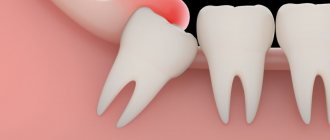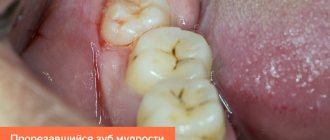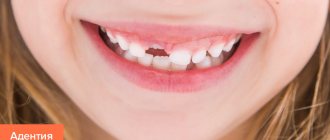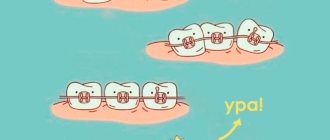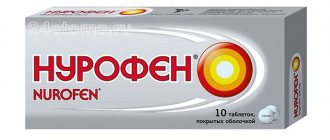We are accustomed to counting teeth by serial number - in children there are 5 on each side of the jaw, in adults there are 8. We know what groups of teeth are called by function - incisors, canines, small (premolars) and large molars (molars). But the very last molars in the adult dentition have a special name - these are wisdom teeth. They are called that because they are the last to emerge, not earlier than 16-17 years of age.
And you shouldn’t wait for them before this date. Often parents mistake ordinary chewing teeth (6th and 7th), which appear at the end of the dentition on a free area of the alveolar process, for “eights”. In 5-8% of the population, the “eights” are not even formed during embryonic development: women often lack the lower ones, and men, the upper ones.
Causes of hyperdontia
There is no consensus among experts about the reasons for the appearance of extra teeth. There are several versions:
- hyperdontia is a manifestation of atavism;
- the embryonic plate has split into too many tooth germs;
- genetic and hereditary factor.
It is not possible to prevent hyperdontia, so we recommend that parents pay more attention to the dentist’s findings. Timely measures are a guarantee of successful treatment.
What to do after surgery
The recovery period after removing an overgrown root, as a rule, is longer. This is due to the need to cut the gums. Medicines are selected by the doctor individually, depending on the initial condition and complexity of the operation. Typically prescribed:
- Anti-inflammatory drugs. The doctor may prescribe oral anti-inflammatory drugs and rinses.
- Painkillers. After any dental surgery, the patient feels pain. There is no need to take painkillers constantly. If discomfort occurs, you can take any analgesic.
- Healing agents. After surgery, it is important to ensure rapid healing of the wound channel. For better healing of the cut gum and tooth socket, the doctor may prescribe medications that accelerate tissue regeneration and promote rapid healing.
It is important to follow all the doctor’s recommendations, otherwise there is a risk of developing an inflammatory process. After final healing, the patient undergoes prosthetics.
Despite the fact that in the vast majority of cases the overgrown tooth is removed, there are exceptions. For example, if the crown was destroyed due to injury, the root is strong and healthy, a new crown can be built on it. In any case, the doctor makes the decision to remove or preserve the root based on the results of the examination.
Why is it dangerous
Taking into account the number, location, size of the jaw and the age of the patient, the negative consequences are:
- delayed eruption of primary teeth;
- the formation of a diastema - a gap between the front incisors;
- damage to the mucous membrane leading to inflammation;
- inability to comply with hygiene measures;
- violation of the chewing process and digestive problems;
- the impossibility of proper oral hygiene and, as a consequence, the spread of carious bacteria.
What parents should pay attention to
In order to reduce the likelihood of difficult eruption of wisdom teeth, parents should monitor the condition of the dental system in children from a very early age. The key to normal jaw development is breastfeeding, which involves the entire musculature of the maxillofacial area.
To prevent jaw deformities from forming, it is necessary:
- Wean your child off pacifiers.
- Fight bad habits such as sucking fingers and toys, biting your lip or cheek.
- Prevent rickets, which negatively affects the structure of the jaws.
- Make sure to maintain nasal breathing, since when breathing with an open mouth, the child’s lower jaw lags behind in development.
- Change the child's position while he sleeps.
- Treat teeth in a timely manner, preventing the development of inflammatory processes in the jaw bones.
- Regularly conduct preventive dental examinations with pediatric dentists.
These measures will remove barriers to jaws reaching their natural size, ensuring wisdom teeth have their rightful place in the dentition.
If a teenager has troubles when cutting through the “eight”, he should immediately contact a dental surgeon, who will determine the final fate of the insidious tooth. The specialists of the Shifa clinic are always ready to provide qualified assistance in both preventive and therapeutic areas. Our center employs doctors specializing in pediatric dentistry. We find an approach to every child.
Symptoms and diagnosis
This deviation has visual signs, so a good dentist will detect hyperdontia at the first manifestations. Signals that may indicate supernumerary teeth in a child:
- speech defects (lisp, swallowing sounds);
- displacement of the dentition, malocclusion;
- slowing down the appearance of molars;
- malfunction of the gastrointestinal tract;
- rotation of healthy teeth around their axis.
Extra teeth have weak and crooked roots. They grow in an abnormal order, and the shape can be different, mainly in the form of a cone. Size is smaller than that of healthy people. Parents manage to detect hyperdontia when the central incisors erupt. To confirm or refute your guess, visit your dentist.
Family Dentistry will take an x-ray or perform a 3D tomography to determine the location of extra teeth and their exact number.
Problems
According to statistics, four out of five people experience complications during the eruption of wisdom teeth. They can be very diverse:
- Anomalies in size and shape that make their removal an unpredictable process.
- Undetermined number of roots.
- Dystopia is the appearance of a tooth outside the dental arch.
- Significant deviation from the vertical axis.
- Displacement of the remaining teeth, causing crowding in the anterior region and malocclusion.
- Neoplastic processes associated with the preservation of the follicle membrane.
- Inflammatory processes as a consequence of difficult eruption:
- pericoronitis (pericoronitis) - inflammation of the mucous membrane covering the chewing surface of the figure eight with the so-called hood;
- periostitis - inflammation of the periosteum (in everyday life called “flux”);
- osteomyelitis - purulent inflammation in the bone;
- abscess - an abscess in soft tissues;
- phlegmon is a diffuse purulent inflammation of soft tissues.
Often wisdom teeth are not sufficiently mineralized and are therefore susceptible to caries.
Treatment of supernumerary teeth in children
Babies sometimes develop their first extra teeth immediately after birth. In this case, breastfeeding is a difficult test - the mother's nipple is constantly injured, and the baby's mucous membrane is damaged. In this situation, the teeth need to be removed urgently. If the supernumerary tooth erupted during the period when the child’s milk teeth were not replaced by molars, it will be removed. And to correct the bite, the intervention of an orthodontist will be required.
Difficulties arise if the extra tooth turns out to be impacted or semi-impacted - that is, it did not erupt and remained under the gum. Then dentists will prescribe special procedures:
- vibration stimulation;
- stimulating massage;
- electrical stimulation.
This will help speed up teething. Then the dentists decide whether to remove such a tooth or leave it. Sometimes doctors decide to save extra teeth if they do not interfere with the remaining teeth erupting in their place and do not spoil the bite. Modern techniques quickly solve the problem of hyperdontia if you consult a doctor at an early stage. Therefore, Family Dentistry specialists recommend visiting the dentist twice a year and teaching children to do this from an early age.
Wisdom teeth
X-ray images convincingly prove that at the time of birth, the child’s jaw contains two rows of complete sets of the rudiments of milk and permanent teeth in different stages of formation. The smallest translucent “vesicle follicles” located at the end of the rows are the future wisdom teeth.
A baby's jaws are small. They only accommodate 5 primary teeth on each side of the midline. As the jaw grows, a free space is formed behind the outer teeth, in which the first permanent molar, the “six” and then the “seven,” erupts. At this time, the wisdom tooth very slowly goes through the stages of formation and mineralization.
Complete ossification of the jaw ends by 15-16 years. And it often turns out that there is not enough space for a wisdom tooth on the alveolar process. In 25% of cases, fully formed “eights” remain hidden in the bone. Then they talk about their retention.
Useful tips
Before removing an incorrectly positioned wisdom tooth, we offer a number of tips that will help you prepare and go through the operation more comfortably:
- Try to make an appointment for tooth extraction in the morning. During the night, the hormone cortisol accumulates in the body, which helps to survive stressful situations. In addition, one should take into account the fact that the inevitable bleeding from the wound at the site of the former tooth will stop by the evening, and the person will be able to sleep peacefully.
- Eat well before surgery. As a result, saliva will be released in smaller volumes, and then you will need to leave your jaws alone and not eat for some time.
- If possible, immediately use a cold object and periodically apply it to your cheek on the way home to prevent swelling from forming. A pack of dry ice from a motorist's first aid kit will do.
- At home, rinse your mouth with clean water or medications recommended by your doctor.
- Take medications in the correct dosage, do not get carried away with self-medication and self-prescription of drugs.
Recommendations for a better rehabilitation period after removal of an impacted wisdom tooth:
- You will need to allow a blood clot to form at the site of the extracted tooth. His presence is mandatory. The clot protects the socket from the penetration of bacteria and prevents complete deformation of the gums. Dry socket is dangerous and provokes inflammation.
- Do not touch the blood clot with your tongue, toothbrush bristles, or cutlery. It is not even recommended to use mouth rinse for 2-3 days after surgery. It is better to take the medicine into your mouth, hold it for a while and spit, avoiding the chance of dislodging the clot.
- To stop bleeding, it is permissible to use sterile cotton wool or gauze swabs. It is allowed to moisten with Chlorhexidine, Miramistin. It is prohibited to use hydrogen peroxide!
- For several days you will have to eat soft food and maintain an acceptable temperature of food and drinks.
- You are supposed to temporarily give up physical activity and training. Baths and saunas, swimming pools, solariums are prohibited.
- You cannot heat the surgical area, as this will cause a dangerous inflammatory process. You can apply ice, but under no circumstances keep it on your cheek all the time. Optimal rhythm: 5 minutes cooling, 5 minutes break. If you don’t have ice at home, bags of frozen vegetables and meat from the freezer will do.
- Maintaining oral hygiene is not prohibited. The main thing is to leave the operated area alone in the first days and not try to thoroughly clean the teeth located near the wound. Disinfection can be carried out with solutions of Chlorhexidine, Furacilin, holding it in the mouth and spitting it out, without rinsing.
Medicine knows of cases when wisdom teeth are prescribed to be preserved. But if it grows, pushing neighbors, lies horizontally or rests on the roots of nearby teeth, there is no need to think twice. Such an eight is considered problematic and is deleted without regret.
